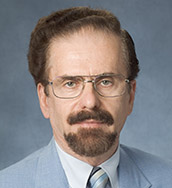Chaos theory may explain instability in US economy

LAWRENCE — Jeff Goldblum’s character in “Jurassic Park” famously popularized the concept of chaos theory as it relates to science. But one University of Kansas professor is applying that theory to the economy.

William Barnett, the Oswald Distinguished Professor of Macroeconomics, has co-written “Shilnikov Chaos, Low Interest Rates, and New Keynesian Macroeconomics” (PDF) The research paper argues that an active monetary policy, using feedback to interest rates, may introduce a chaotic attractor, initiating long-term unpredictability in financial markets.
“The puzzling decline in nominal and real interest rates over the past 20 years may not have been intentional,” Barnett said.
“By attaching a Taylor interest-rate feedback rule to the macro economy’s dynamics, the central bank inadvertently bifurcated the economy into Shilnikov chaos — which we have shown can produce drift of interest rates down to below their natural rate.”
Those familiar with “Jurassic Park” likely understand how chaos applies to the natural sciences, causing solution paths to wander in unplanned directions.
“In ‘Jurassic Park,’ dinosaurs unintentionally got out of control. That’s possible from one kind of chaos. There could be another kind of chaos, which can do the opposite. It could cause the extinction of the dinosaurs. So that movie was assuming the existence of a particular kind of chaos, which had a very negative consequence,” he said.
But Shilnikov chaos (named for Russian mathematician Leonid Shilnikov) generates its own distinct kind of dynamical drift.
“We have found it can cause interest rates inadvertently to decline, even if not intended by the Federal Reserve,” Barnett said.
The KU professor explained that people often confuse this with something called catastrophe theory.
“In mathematics, catastrophe theory produces discontinuous jumps in solution paths. Chaos doesn’t do that. It just produces jiggly, stochastic-appearing solutions that are not smooth — such as the weather, which is chaotic, never converges to a steady state and is not perfectly predictable,” he said.
Although the concept may be tricky to grasp, the outcome is quite tangible.
He said, “There is much concern in the media about what central banks throughout the world will do the next time there is a recession. Central banks try to offset recessions by lowering interest rates. But if those rates are near zero at the so-called lower bound, called the ‘liquidity trap’ by economists, it’s not clear that the bank’s normal policy instruments can deal with the consequences of another recession.”
This research not only provides an explanation of a source of the problem but also proposes solutions.
Barnett co-wrote the paper with four other economists. While collaboration is typical for a project of this sort, the way in which it was accomplished proved rather unique. Three of the researchers — Giovanni Bella, Paolo Mattana and Beatrice Venturi — are based in Italy. Taniya Ghosh, a former KU doctoral student of Barnett’s, works in India.
“My correspondence with the Italians goes back and forth through Taniya,” Barnett said. “It’s an unusual way to do research, but surprisingly it’s been working out very well in a very cooperative manner.”
In fact, some of the paper’s revisions were suggested by Andrey Shilnikov, son of the mathematician upon whose theory the research is based.
A native of Boston, Barnett was originally a scientist for Rocketdyne, a Los Angeles company that created rocket engines for the Apollo program.
“Chaos in nonlinear dynamics were very important to us when we were trying to understand what was going on with rocket engines on test stands,” he said.
He then spent eight years on staff of the Federal Reserve Board in Washington, D.C. He said this introduced a personal interest in his subsequent research as to why the board’s policy “seems to have had unintended consequences in recent years.”
Barnett has worked at KU for the past 16 years as an expert in econometrics and macroeconomics. He is founder and editor of the Cambridge University Press journal Macroeconomic Dynamics and the Emerald Press monograph series International Symposia in Economic Theory and Econometrics. Barnett founded the Society for Economic Measurement and served as its first president. Additionally, he is director of the Advances in Monetary and Financial Measurement program at the Center for Financial Stability in NYC.
He is also the namesake of the “Barnett critique.”
“To produce monetary aggregates, many central banks just add up imperfect substitutes without weights — such as currency, demand deposits, passbook accounts and certificates of deposit — despite the fact they contribute different amounts of liquidity to the economy. For example, currency produces much more liquidity than non-negotiable certificates of deposit. The Barnett critique says using those added-up data creates the appearance of instability of the demand for money function, when in fact, the economy’s structure, including the important demand for money function, is not necessarily unstable,” he said, noting that the Bank of England has officially adopted his Divisia monetary aggregates.
Barnett hopes his “Shilnikov Chaos” paper will also generate real-world adjustments.
“I would like economists to take more seriously what is known as systems theory by physicists, engineers and mathematicians,” he said. “Clearer comprehension of systems theory would produce more sophisticated understandings of how best to conduct policy in Washington, D.C.”